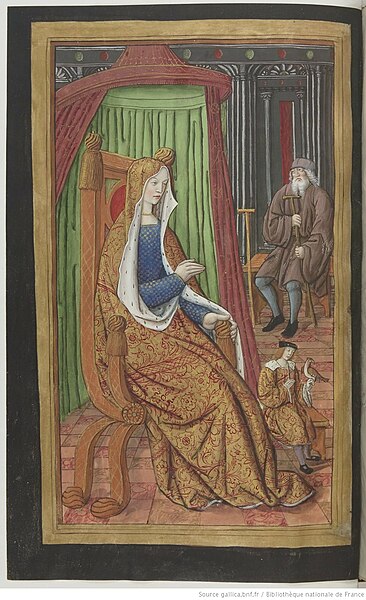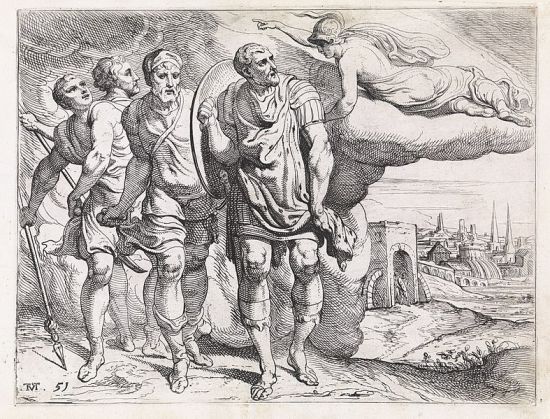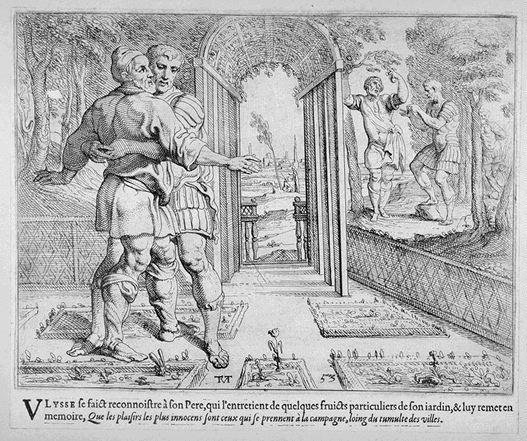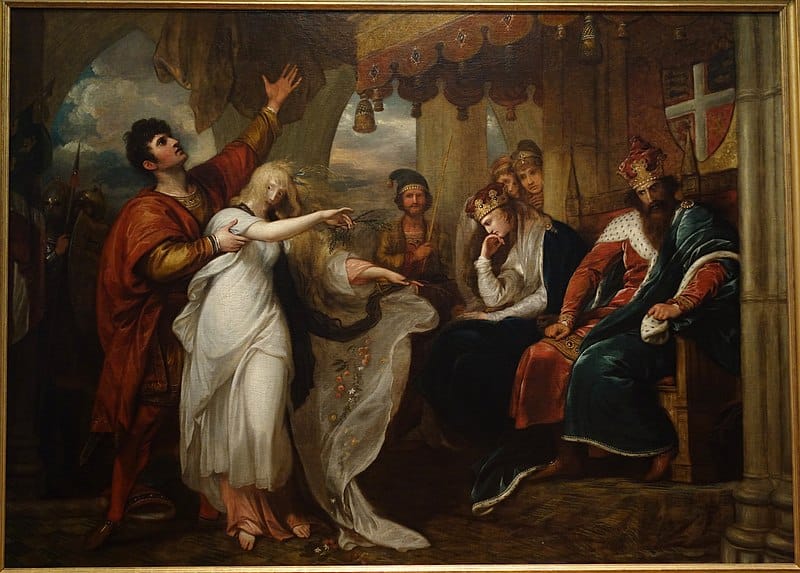Laertes often takes a backseat in the grand narrative of Greek mythology, especially when compared to his illustrious son, Odysseus. Yet, his story, rooted in the quiet heroism of familial bonds and loyalty, holds its own charm.
As the King of Ithaca before Odysseus, Laertes’ life is a humble yet significant thread in the larger mythological tapestry. His tale provides a softer echo of valor amidst the roaring tales of gods and demigods, making him a character worth delving into.
Laertes Key Facts
| Parents | Arcesius and Chalcomedusa |
| Partners | Anticlea |
| Siblings | None known |
| Offspring | Odysseus |
| Other names | N/A |
| Roman name | Laertes |
| Best Known Myth | Father of Odysseus, and his role in the Odyssey |
Name and Etymology
The name Laertes, while not enveloped in grandiose mythological tales, holds its own significance. It’s derived from the ancient Greek word Laertēs, a name whose etymology, though not definitively traced, often is believed to have roots in the ancient dialects spoken in the regions around Ithaca. Unlike many of his contemporaries, Laertes doesn’t boast a Roman counterpart or a plethora of epithets, his identity remains simple and unadorned, much like his life.

In the broader spectrum of Greek mythology, names often carried profound meanings, reflective of the individual’s destiny or inherent traits. However, Laertes’ name doesn’t follow this pattern, which in itself is a reflection of his unique, understated presence amidst the flamboyant heroes of his time. His name is a whisper amidst the roaring tales of Hercules, Achilles, and of course, his own son Odysseus.
The absence of a Roman name or other epithets for Laertes further underscores the modesty and simplicity that defines his character. Unlike the mighty Zeus who is known as Jupiter in Roman mythology, or his son Odysseus, known as Ulysses, Laertes’ identity remains unaltered across cultures, a quiet, unassuming echo through the annals of mythological history.
Laertes Family and Relationships
Laertes was born to Arcesius and Chalcomedusa, a lineage that tied him to the royal blood of Ithaca, an island known more for its idyllic beauty than the might of its kings. His marriage to Anticlea, the daughter of the infamous thief Autolycus, brought forth Odysseus, who would go on to eclipse the fame of his father. Yet, the bond between Laertes and Odysseus is a testament to the former’s nurturing, protective nature.
The narrative surrounding Laertes’ birth or early childhood isn’t as embellished or dramatic as those of many Greek heroes. His life was seemingly marked by a steady, uneventful rhythm, a stark contrast to the turbulent, adventure-laden lives of his son and many of his contemporaries. This tranquility, however, was disrupted by the Trojan War, a monumental event that swept away his son to the battlefields, leaving Laertes in a state of perpetual anxiety.
Laertes’ love life, unlike the many tumultuous or tragic stories in Greek myths, was marked by stability and loyalty. His relationship with Anticlea was not the stuff of epic poems. However, it was a bond that bore the hero Odysseus, a testament to the quiet, enduring legacy of Laertes.
Myths about Laertes
Laertes’ mythology is not adorned with a multitude of adventures or battles against formidable foes. However, his narrative is intertwined with the epic journey of his son, Odysseus, especially during the latter’s return to Ithaca.
Role in the Odyssey
In the Odyssey, Laertes is depicted as a forlorn figure. Forever pining for his son amidst the olive trees of his estate. His existence, overshadowed by the prolonged absence of Odysseus, reflects the emotional turmoil endured by those left behind. The simplicity of his life, tending to his orchard, is a poignant contrast to the tumultuous, danger-ridden journey of Odysseus.

The moment of reunion between father and son is a touching scene in the Odyssey. It’s not just a personal reunion, but also a restoration of rule in Ithaca, as Odysseus takes back the throne. Laertes, despite his old age, even aids his son in fighting off the families of the suitors who had plagued his wife Penelope during his absence.
Laertes’ role in the Odyssey, though not central, is crucial in underscoring the emotional and moral dimensions of Odysseus’ journey. His presence serves as a reminder of the familial bonds and the sense of duty that drives Odysseus through the trials and tribulations he faces.
Depiction And Characteristics
Laertes’ depiction in Greek mythology is that of a humble, patient, and loving father. His appearance isn’t described with the grandiose terms often reserved for gods and demigods; instead, he is portrayed as a simple, aging man, often seen tending to his orchard. This humble imagery is a stark contrast to the heroic, larger-than-life portrayals of his son and other Greek heroes.
The orchard, a place of solitude and reflection for Laertes, becomes a symbol of his quiet, nurturing nature. Unlike the thunderbolts of Zeus or the mighty shield of Achilles, Laertes’ association with the serene, life-giving orchard paints a picture of a different kind of heroism. It is one rooted in patience, care, and a deep bond with nature.
Laertes’ personality, as gleaned from the texts, is one of resilience and enduring love. His unwavering hope for his son’s return, his patience through years of uncertainty, and his ability to fight alongside Odysseus in the hour of need, despite his advanced age, are reflective of a stoic, steadfast character.
The absence of any specific animals or plants, besides the olive trees of his orchard, associated with Laertes further emphasizes the simplicity and modesty that define his character. His is a tale that resonates with the virtues of patience, familial love, and quiet resilience, offering a soothing narrative amidst the stormy sagas of Greek mythology.
Representations Of Laertes In Art
Laertes’ presence in the realm of art is not as pronounced as many other figures from Greek mythology. However, there are instances where he has been depicted, often in scenes from the Odyssey. Focusing particularly on the emotional reunion with his son, Odysseus.

The portrayal of Laertes in art often echoes the textual descriptions of him as a humble, aging figure. Unlike the depictions of gods and heroes, Laertes is often shown as a man marked by the passage of time. However, with a glimmer of enduring strength in his eyes.
The modest number of artworks featuring Laertes, compared to the plethora dedicated to more flamboyant figures like Zeus or Hercules, is a reflection of his understated, yet significant role in Greek mythology. His portrayal, though not as grand, resonates with a quiet dignity and a subtle, enduring legacy.
Mentions in Ancient Texts
Laertes’ mentions in ancient texts primarily revolve around his role as Odysseus’ father and his appearance in the Odyssey.
Homer’s Odyssey
Homer, in his epic Odyssey, penned around the 8th century BC, provides the most significant glimpse into Laertes’ life. Through the narrative, we see Laertes as a father yearning for his son. His days shadowed by the uncertainty of Odysseus’ fate.
In the Odyssey, Laertes utters, “O father Zeus, surely you gods made the sons of the Achaians utterly destructive, beyond others, since I fathered a son blameless and strong, and he grew to be a hero among the Danaans, and I left him and came here.” This excerpt encapsulates the emotional turmoil and the sense of loss that pervades Laertes’ existence in the absence of Odysseus.
Frequently Asked Questions
Laertes is best known as the father of Odysseus and for his role in the Odyssey. Particularly so during the reunion with his son and the subsequent battle against the suitors’ families.
Laertes is depicted as a humble, aging figure, often seen tending to his orchard. His character embodies patience, familial love, and a quiet resilience.
Unlike many other figures in Greek mythology, Laertes’ narrative doesn’t encompass grand adventures. His story is more about his familial bonds and his life in Ithaca.
After reuniting with Odysseus and aiding him in battle, it’s implied that Laertes lives out his remaining days in peace. He is finally free from the anxiety of his son’s absence.
Their relationship is portrayed as a strong, loving bond. Laertes’ longing for Odysseus during his absence and their emotional reunion underscore the deep familial ties between them.
The orchard symbolizes Laertes’ nurturing nature and connection to the land as well as his peaceful, simple life. Contrasting with the turbulent adventures of Odysseus.
Featured Image Credit: Benjamin West, CC0 1.0, via Wikimedia Commons

